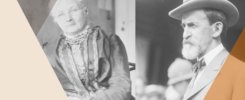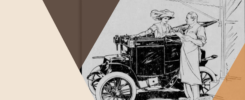Transcript for Episode 1 of the 2024/2025 Season of Talking Hoosier History
Episode written by Kelsey Green, produced by Jill Weiss Simins, and hosted by Justin Clark.
[Audio of P-47 Flyby]
[Audio of guns on the P-47]
On April 27, 1943, P-47 Thunderbolts dipped, dived, and weaved through the sky. The tight formation reached speeds over 400 MPH and shot their eight 50-calibre machine guns in rapid succession, sending mounds of dirt bursting in the air. One observer described the planes “like rockets” climbing into space.
Despite being WW-II fighter-bombers, these planes were not soaring over Normandy or Berlin. They were zig-zagging the blue skies of Evansville, Indiana, performing a demonstration for President Franklin D. Roosevelt. The air show was part of a larger presidential visit during which FDR toured the Evansville P-47 plant. He inspected the assembly lines, met with plant workers, and presented exceptional employees with model P-47 planes. When asked for his thoughts on the factory FDR expressed admiration saying, “This is a very important place. We hear a lot about it.”[i]
Today, the P-47 is considered one of the most important fighter aircraft in World War II. Manufactured by Republic Aviation Corporation and debuted in 1943, pilots flew P-47s in both the European and Pacific theaters. During the war, Republic Aviation operated two plants— one in Farmingdale, New Jersey and the second one in Evansville. By the end of the war, Allied forces had performed over half a million missions in the P-47, shooting down more Luftwaffe aircraft than any other Allied fighter.[ii]
While military history often focuses on aircraft design and the pilots who flew them, the people who built these planes are equally intriguing. In fact, the manpower behind P-47 production may be more aptly described as womanpower. Known as “Raiderettes,” these women served in many positions at the Republic plants. The Evansville Raiderettes’ hard work, sacrifices, and patriotism contributed to the production of over one-third of the Thunderbolts manufactured during World War II.
I’m Justin Clark, and this is a short episode of Talking Hoosier History.
Narrative
Republic Aviation Corporation in Evansville sought to hire a substantial number of women workers because men were fighting overseas. The company recruited women through newspaper advertisements and provided free classes for workers to learn a variety of factory skills.[iii] Once trained, Raiderettes could be found working side by side with men in machining parts, welding metal, wiring electrical components, inspecting aircrafts, and transporting supplies. Others worked in administration, writing for the company newspaper, filing papers, or working logistics. So, there was no singular experience among the Raiderettes.
Women across the plant embraced their varied roles, seeing them as a patriotic duty, and exceeded the expectations of the public, many of whom believed women were not suited to manufacturing work. The Muncie Evening Press reported that, with some tasks, women workers across the country exceeded men’s production output by 10 percent or more.[iv] Day-to-day life in the plant consisted of 10 to 14-hour shifts across various departments and, for many, included long commutes of up to 80 miles a day.[v]
Raiderettes nevertheless experienced gender bias at Republic Aviation. Often, the women’s workplace demeanor was more heavily scrutinized than men’s. One column in the company’s newspaper, Republic Aviation News, cautioned women against “super-sensitiveness” in the workplace and frequently commented on female employees’ outfits or social behaviors. In this way, women were expected to do a “man’s job” while still adhering to traditional gender roles.
Still, Raiderettes pushed against and broke the glass ceiling in various ways. For example, Naomi Johnson served as the first female restricted radio operator in the region, using advanced aircraft radios to communicate and direct pilots. Due to her strong interest in and advanced knowledge of aviation, she was made an honorary member of the Civil Air Patrol.[vi] When interviewed by Republic Aviation News, Johnson expressed her passion for her work, stating, “The thing I like best about radio work is the fact that it’s something you can never learn enough about. You can just keep studying and studying. But I wouldn’t mind being called a book-worm if I could read about radio.” [vii]
Other women broke barriers as well, such as Eunice Hall, who served as the first reclamation agent at Republic, a new position that encouraged the conservation of factory materials to reduce waste in the various plant divisions.[viii] Others, such as Betty Gillies and the Women Airforce Service Pilots, colloquially known as WASPs, were elite civilian pilots who supported the war effort by ferrying, testing, and transporting planes.[ix]
Raiderettes held diverse roles within Republic Aviation and navigated their new, public-facing roles in a variety of ways. However, the common thread of all these women is that they collaborated with both male workers and one another, pushing against traditional gender roles to honorably serve the United States during World War II.
Conclusion
On August 21, 1945, Republic Aviation announced they would be ending all production at Evansville. Upon its closure, the plant had produced over one-third of all P-47 Thunderbolts in the world, hired thousands of employees, and infused millions of dollars into the local economy. Undoubtedly, the work of the women at the Evansville Republic Aviation plant helped win the war and challenge traditional gender barriers. While many eventually returned to their prior occupations and roles, Raiderettes remained proud of their contributions and fondly recalled their time at the factory. Through examining their histories, which were often told in the Raiderettes’ own words through both oral histories and the company newspaper, we can better understand the lived experiences of women wartime workers and their contributions to the country.
When reflecting upon the legacy of the Evansville Raiderettes, it is perhaps best summarized by Republic Aviation News columnist LaVerne Heady.
Sometimes when you think back over your old history texts, and remember that the accounts there relate the deeds of men- not women- doesn’t it give you a marvelous feeling to realize that the greatest chapter of history of mankind is being written today, and that you women are going to have your names in the headlines?
Outro & Historical Markers
Want to learn more about the Raiderettes or Evansville’s role in World War II? Check out our blog post, “The Raiderettes: The Women Who Built Evansville’s P-47 Thunderbolts,” by IHB historian Kelsey Green. You can also learn more about Indiana’s role in WWII through our state marker program. We recently installed a P-47 Thunderbolt marker in Evansville which examines the impact of the Republic Aviation Factory discussed today. Similarly, our WWII Army Ammunition Plant Marker explores the role of the DuPont ammunition plant in Charlestown and its role in manufacturing powder propelled projectiles for Allied Forces. Visit our website for more information on WWII era markers!
We hope you liked this episode of the podcast. Let us know! Subscribe, rate, and review us wherever you get your podcasts. Once again, I’m Justin Clark, and this has been Talking Hoosier History. Thanks for listening.
[i] “Roosevelt Visits Evansville; Sees P-47 Dive at 500 M.P.H.,” Indianapolis News, April 29, 1943, accessed Newspapers.com; “President’s Visit to City Described in Belated News,” Evansville Courier and Press, April 30, 1943, accessed Newspapers.com.
[ii] “Republic P-47 Thunderbolt,” National Museum of World War II Aviation, accessed https://www.worldwariiaviation.org/aircraft/republic-p47-thunderbolt; National Air and Space Museum, “Republic P-47D-30-RA Thunderbolt,” Smithsonian Institution, n.d., accessed https://www.si.edu/object/republic-p-47d-30-ra-thunderbolt%3Anasm_A19600306000.
[iii] “College to give Classes in War Work,” Evansville Press, September 12, 1943, accessed Newspapers.com; “Day War Training Classes Planned,” Evansville Courier, October 15, 1943, accessed Newspapers.com; “These Doors Never Close: Mechanic Arts School Has Prominent Part in War Work Training Program,” Evansville Courier and Press, July 2, 1942, accessed Newspapers.com; Mary Ellen Ward, “Diary of a Riveter,” Republic Aviation News, February 12, 1943, accessed Indiana State Library.
[iv] “Two-Job War Worker: She Does a Man-Sized Job on Production Line Plus ‘Women’s Work’ of Maintaining a Home,” Muncie Evening Press, November 5, 1942, accessed Newspapers.com.
[v] James Russell Harris, “Rolling Bandages and Building Thunderbolts: A Woman’s Memories of the Kentucky Home Front, 1941-1945,” The Register of the Kentucky Historical Society, (Spring 2002): 167-194, accessed JSTOR.
[vi] “First Woman Restricted Radio Operator in This Region is Republic’s Naomi Johnson,” Republic Aviation News, September 3, 1943, accessed Indiana State Library.
[vii] “First Woman Restricted Radio Operator in This Region is Republic’s Naomi Johnson,” Republic Aviation News, September 3, 1943, accessed Indiana State Library.
[viii] “Utility Shop Girl Becomes First Official Reclamation Agent at Indiana Division,” Republic Aviation News, January 7, 1944, accessed Indiana State Library.
[ix] First Woman Ever to Fly a Thunderbolt is One of Two Girls Landing Here in P-47s,” Republic Aviation News, October 15, 1943, accessed Indiana State Library; “First Squadron of Girl Pilots Here to Fly P-47’s,” Republic Aviation News, August 1, 1944, accessed Indiana State Library.
For addition sources, notes, and information view Kelsey Green’s full blog post at Untold Indiana.


